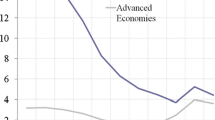Abstract
We investigate the relationship between non-performing loans (NPLs ) and their fundamentals, mainly bank and macroeconomic variables . This is done based on aggregate portfolio loans from the Greek economy. This economy constitutes an interesting case to study the factors determining NPLs , given the pervasive recessionary conditions held in it after the global financial crisis and the outbreak of its sovereign debt crisis occurred in the year 2010. We suggest a new econometric framework to study the above relationship which extends the SUR (seemingly unrelated regressions) framework to allow for a common break in its slope coefficient of unknown time. We show that the deterioration in the macroeconomic conditions (captured by very high rates of unemployment ) and political uncertainty constitute key factors in explaining the sharp rise of NPLs of the Greek banking sector after the first quarter of the year 2012. With the exception of bank profitability, we find that bank-specific variables associated with bank capitalization and liquidity risk seem to determine NPLs only under normal economic conditions.
Access this chapter
Tax calculation will be finalised at checkout
Purchases are for personal use only
Similar content being viewed by others
Notes
- 1.
Note that, since the intercepts of the model \( c_{i} \) are not found to differ across \( i \), in the implementation of test statistic LR-stat we assume that under the null hypothesis \( c = c^{ * } \), for all \( i \).
References
Anastasiou, D., Louri, H., & Tsionas, M. (2016). Determinants of non-performing loans: Evidence from Euro-area countries. Finance Research Letters, 18, 116–119.
Andrews, D. W. K. (1993). Tests for parameter instability and structural change with unknown change point. Econometrica, 61, 821–856.
Bank of Greece. (2012). Annual report 2012. Athens: Bank of Greece.
Beck, R., Jakubic, P., & Piloiu, A. (2013). Non-performing loans: What matters in addition to the economic cycle? (ECB Working Paper Series).
Berger, A. N., & DeYoung, R. (1997). Problem loans and cost efficiency in commercial banks. Journal of Banking & Finance, 21, 849–870.
Borio, C. (2014). The financial cycle and macroeconomics: What have we learnt? Journal of Banking & Finance, 45, 182–198.
Dendramis, Y., Kapetanios, G., & Tzavalis, E. (2014). Level shifts in stock returns driven by large shocks. Journal of Empirical Finance, 29, 41–51.
Dendramis, Y., Tzavalis, E., & Adraktas, G. (2017). Modelling credit risk under recessionary and distressed financial conditions. Journal of Banking and Finance, Forthcoming.
Gertler, M., Kiyotaki, N., & Queralto, A. (2012). Financial crises, bank risk exposure and government financial policy. Journal of Monetary Economics, 59, S17–S34.
Klein, N. (2013). Non-performing loans in CESEE: Determinants and impact on macroeconomic performance (IMF Working Paper).
Louzis, D., Vouldis, A., & Metaxas, V. (2012). Macroeconomic and bank-specific determinants of NPLs in Greece: A comparative study of mortgage, business and consumer loan portfolios. Journal of Banking & Finance, 36, 1012–1027.
Makri, V., Tsagkanos, A., & Bellas, A. (2014). Determinants of non-performing loans: The case of Eurozone. SPOUDAI Journal of Economics and Business, 65, 119–143.
Monokroussos, P., Thomakos, D., & Alexopoulos, T. (2016). High NPLs in Greece: Outcome of an unprecedented recession or lending practices of domestic credit institutions in the pre-crisis era? Working Paper, Eurobank Global Markets Research.
Pagratis, S., Lolou, C., & Vettas, N. (2017). Existing corporate and household insolvency frameworks: Characteristics, weaknesses and necessary reforms. In P. Molyneux (Ed.), Resolving private sector insolvency (pp 337–362). Palgrave Macmillan Studies in Banking and Financial Institutions.
Podpiera, J., & Weil, L. (2008). Bad luck or bad management? Emerging banking market experience. Journal of Financial Stability, 4, 135–148.
Quagliarello, M. (2007). Banks’ riskiness over the business cycle: A panel analysis on Italian intermediaries. Applied Financial Economics, 17, 119–138.
Salas, V., & Saurina, J. (2002). Credit risk in two institutional regimes: Spanish commercial and savings banks. Journal of Financial Services Research, 22, 203–224.
Acknowledgements
The authors would like to thank I. Assimakopoulos, D. Christelis, D. Georgarakos, H. Gibson, H. Louri, P.Monokroussos, S., Pagratis, G. Palaiodimos, A. Philippopoulos and A. Samitas, as well as the seminar participants at AUEB for useful comments and suggestions. The views presented in the paper are those of the authors alone and do not necessarily reflect the views of their respective institutions. Yiannis Dendramis acknowledges support from the European Union’s Horizon 2020 research and innovation programme under the Marie Sklodowska-Curie grant agreement No 708501.
Author information
Authors and Affiliations
Corresponding author
Editor information
Editors and Affiliations
Rights and permissions
Copyright information
© 2017 The Author(s)
About this chapter
Cite this chapter
Charalambakis, E., Dendramis, Y., Tzavalis, E. (2017). On the Determinants of NPLs: Lessons from Greece. In: Bournakis, I., Tsoukis, C., Christopoulos, D., Palivos, T. (eds) Political Economy Perspectives on the Greek Crisis. Palgrave Macmillan, Cham. https://doi.org/10.1007/978-3-319-63706-8_13
Download citation
DOI: https://doi.org/10.1007/978-3-319-63706-8_13
Published:
Publisher Name: Palgrave Macmillan, Cham
Print ISBN: 978-3-319-63705-1
Online ISBN: 978-3-319-63706-8
eBook Packages: Economics and FinanceEconomics and Finance (R0)




